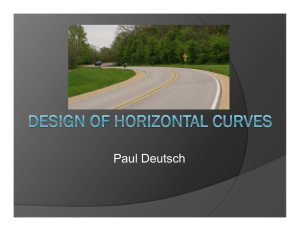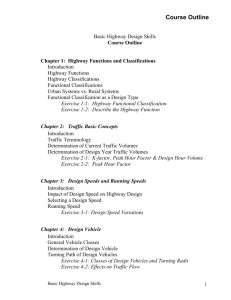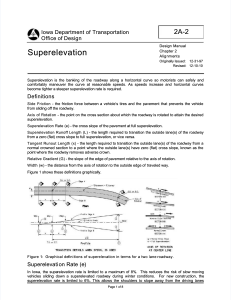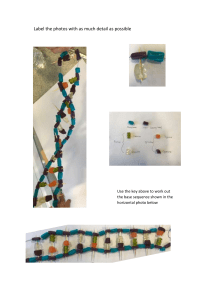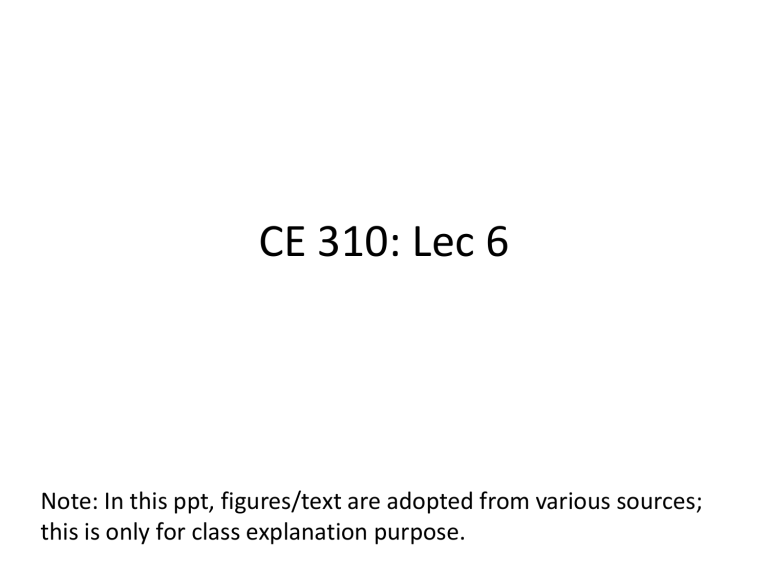
CE 310: Lec 6 Note: In this ppt, figures/text are adopted from various sources; this is only for class explanation purpose. Course content Introduction to transportation systems engineering: • Introduction to transportation Engineering; and Definition of transportation engineering • Issues with transportation system Highways: • Geometric design (Alignment planning and design, design controls and criteria, sight distance, horizontal alignment, vertical alignment, Geometric design at intersection); • Highway materials testing and characterization; • Pavement analysis and design (Flexible and Rigid); • Highway construction, maintenance, management and rehabilitation. Horizontal Alignment • Often changes in the direction are necessitated in highway alignment due to various reasons such as topographic consideration, obligatory points. • Geometric design elements pertaining to horizontal alignment of highway should consider safe and comfortable movement of vehicles. • Sudden change In direction with sharp curves or reverse curves, should be avoided. • Improper design of horizontal alignment of roads would result in higher accident rate and increase in vehicle operating cost. Design of Horizontal Alignment Horizontal Alignment Design elements to be considered for setting horizontal alignment are: • Super-elevation • Widening of pavement on curves • Radius of circular curve • Set-back distance • Type and length of transition curve Centrifugal Force on Curves • Curve in plan provides change in direction to centre line of road • Forces acting on vehicle while traversing the curve ➢ Centrifugal force (acting outwards through CG of vehicle) ➢ Transverse Frictional Resistance (opp. to Centrifugal force) • Equation of Centrifugal Force ➢ P: Centrifugal force, kg ➢ W: Vehicle Weight, kg ➢ R: Radius of circular curve, m ➢ v: Vehicle Speed, m/s ➢ g: Acceleration due to gravity = 9.81 m/s2 • Effects due to centrifugal force: (1) Overturning (2) Lateral skidding 1. Overturning Effect Centrifugal force tends the vehicle to overturn about the outer wheel B on horizontal curve without superelevation. h= height of C.G of vehicle above the road surface b= width of the wheel base •Overturning Moment due to Centrifugal Force =Ph •Restoring Moment due to Vehicle Weight = W b/2 •Equilibrium condition P h = W b/2 or P/W = b/2h •Danger of Overturning P/W = v2/g R ≥ b/2h P/W is called centrifugal ratio or impact factor • Increase in height (overloading) • R is short • Speed is high 2. Transverse Skidding Effect Centrifugal force also has tendency to push the vehicle outwards in the transverse direction. Vehicle will skid if centrifugal force exceeds maximum transverse friction force or transverse skid resistance counteracting the centrifugal force •Transverse skid resistance due to friction FA + FB = f (RA + RB) = f W where, f = lateral friction coefficient between tire & pavement (usually 0.15) •Equilibrium condition P=fW •Danger of Skidding when Centrifugal Ratio P/W = v2/g R ≥ f • Speed is high • R is short • Friction is less (wet surface, old tire) Summary of Overturning and Skid – and Geometry • Thus for Horizontal Curve with no superelevation – If – If P/W ≥ b/2h P/W ≥ f then then overturning occurs skidding occurs • To counteract Centrifugal Force and to reduce tendency to overturn or skid Outer edge of pavement is raised with respect to inner edge • This inclination is called Superelevation (or Cant or Banking) Do not get confused with camber or cross slope (The purpose of camber was to drain water off the pavement surface (Typically 1.7 to 2.5 % for flexible and concrete pavements) Superelevation Superelevation • Rate of Superelevation • But as θ is very small Analysis of Superelevation • Analysis of Superelevation For Equilibrium At limiting equilibrium i.e. when FA and FB reach max values of f RA and f RB resp, and Thus, FA+FB = f (RA+RB) Superelevation (contd.) • Analysis of Superelevation Dividing by Wcosθ, f = 0.15, and tanθ seldom exceeds 0.07 or 1/15 Thus ftanθ = 0.01 and 1-ftanθ ≈ 1 Therefore, Superelevation (contd.) • Maximum superelevation Maximum limit of superelevation 7% or (0.07) in plane and rolling terrain. Superelevation (contd.) • Minimum superelevation Superelevation Design: IRC Method • Step 1 – Superelevation for 75% design speed is calculated, neglecting friction (assumption, 75% speed will be taken care by e, rest by friction (f)). (Designing it for high speed, v may cause problem for slow moving vehicle and vice versa). ➢ If e < 0.07, then the value obtained is provided, ➢ If e ≥ 0.07, then consider e = 0.07 and proceed to Step 2 • Step 2 – Find f at e = 0.07 and full design speed as, Superelevation Design: IRC Method • Step 2 (Contd.) – If f < 0.15, then e = 0.07 is safe for design speed If f ≥ 0.15, then calculate restricted speed as in Step 3 • Step 3: Calculate safe allowable speed i.e. Thus, safe allowable speed – Speed is limited to lower of design and allowable speeds Superelevation • Very flat curve large radius, P is small, so normal camber may be retained. However, it will provide negative superelevation (2 lane 2 way highway) • In this situation, check provided “f”, (Usually cumulative effect of P and negative e, may not be significant • Minimum Super-elevation: From drainage consideration, minimum cross slope to drain off water, if e < camber, then provide camber slope Attaining Superelevation • Attainment of Superelevation can be split into 2 parts – Elimination of crown of the cambered section – Rotation of pavement to attain full superelevation • Elimination of crown can be done by two methods Outer Edge rotated about the crown Drainage may issue at some point, where it becomes horizontal or < camber Crown shifted outwards (Diagonal crown method) High negative super-elevation or sharp camber, dangerous. Attaining Superelevation (contd.) • Rotation of pavement to attain full superelevation – When the crown of the camber is eliminated, the superelevation at this section is equal to the camber – But if design superelevation to be provided is more than camber, then pavement section has to be rotated further – This can be done by two methods • By rotating section about centre line • By rotating section about inner edge Attaining Superelevation (contd.) 22 Source: http://user.gs.rmit.edu.au/rod/files/publications/Horizontal%20Curves.pdf Superelevation Class participation-3 1. The radius of a horizontal curve is 100 m and design speed is 50Kmph. Consider coefficient of lateral friction as 0.15 . Find e if full lateral friction is assumed to develop, and Find f needed when no superelevation is provided Solution: V=50kmph R=100m f=0.15 e + f = V2/(127*R) ➔ e = 0.047 Rate of superelevation for full f is 0.047 or 1 in 21.2 When e = 0, f = V2/(127*R) ➔ f = 0.19 Class participation-3 2) Design superelevation rate (using IRC method) for a horizontal curve of radius 500m and speed 100kmph Solution: Step 1: Superelevation for 75% of design speed is, e = V2/(225*R) ➔ e = 0.089 > 0.07 ➔ e = 0.07 Step 2: Checking ‘f’ developed for full speed, f = (V2/(127*R)) – 0.07 ➔ f = 0.087 < 0.15 ➔ Design safe Provide superelevation of 0.07 “Sentiment is a chemical defect on the losing side”- Sir Arthur Conan Doyle
